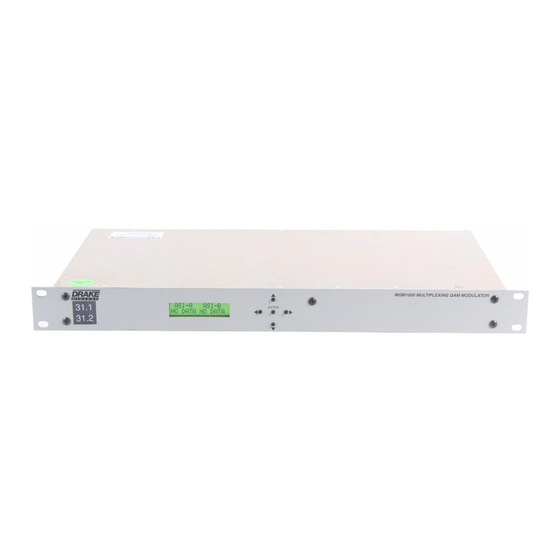DRAKE DQT1000 Kullanım Kılavuzu - Sayfa 5
Modülatör DRAKE DQT1000 için çevrimiçi göz atın veya pdf Kullanım Kılavuzu indirin. DRAKE DQT1000 15 sayfaları. Digital to qam transcoder; multiplexing qam modulator

GENERAL DESCRIPTION
The R.L. Drake model DQT1000 is a professional quality,
digital headend transcoder that receives one or two ATSC,
or ATSC compatible MPEG2, 8VSB or QAM signals from
an off air antenna or from a CATV source. It demodulates
the signals to recover the MPEG2 transport stream(s),
multiplexes the MPEG2 transport streams from DEMOD A
and either the second RF input (DEMOD B) or the ASI
input if used, and modulates the resulting combined
stream using QAM modulation followed by a built in
upconverter for output to a CATV system.
The model MQM1000 does not contain a RF demodulator
but instead accepts one or two ATSC multiprogram
transport streams via two BNC, ASI inputs. When two
streams are input, the MQM1000 then multiplexes the two
ATSC streams in the same manner as the DQT1000.
The DQT1000 and MQM1000 provide essentially the
same function as the popular DQT860 and MQM860 units.
In addition, the '861' and '1000' models provide a program
filter function (a new Select Program menu) and offer
improved upconverter specs with phase noise reduced to
a level that is compatible with QAM modes up though
1024QAM.
The '1000' models provide the same features as the '861'
models except that the upconverter has been upgraded to
allow operation up to 1000 MHz on the output side. The
new '1000' models can be used with the Drake Digital
Headend Remote Control Software, version 2.6 or later,
for remote controlling or remote monitoring of operating
parameters. This program can also be used to download
new firmware into the unit if that ever becomes desirable.
The DQT1000 and MQM1000 operate in a fixed output
clock mode and process null packets when required to
maintain the set fixed clock rate. PCR correction is
included.
DIGITAL CHANNEL PROCESSING
The single input DQT1000, available by special order, is
ideal for digital 'channel processing' applications where a
single digital video signal is received, error corrected,
clocked at a user determined fixed rate and remodulated
on the same or another RF channel. Applications include
cleaning up a low MER QAM signal received from a CATV
source or fiber link receiver, or shifting the RF frequency of
a QAM modulated signal. It may be used to convert one
off-air ATSC 8VSB signal to a QAM output with rate
adjustment. Used in the processor mode with only one
input, the DQT1000 can process ATSC, DVB, or DigiCipher
II compliant MPEG2 inputs that are either VSB or QAM
modulated. No multiplexing or altering of any MPEG
tables is performed in this mode.
ENTER
ASI A
ASI B
26.88dB
24.52dB
General Description
MQM1000 Multiplexing QAM Modulator
Used in the non multiplexing mode, the data rate of the
incoming signal can be any rate that falls within the
specification range. The output rate can be set to any fixed
output rate (equal to or faster than the input rate).
MULTIPLEXING TWO ATSC TRANSPORT STREAMS
With the second RF input/tuner/demodulator (Demod B),
the DQT1000 can accept two 19.4 Mbps ATSC signals
(either with 8VSB modulation or QAM modulation) and
multiplex the transport streams to obtain a 38.8 Mbps
256QAM output. Thus two ATSC inputs can be output on a
single 6 MHz bandwidth 256 QAM channel.
Another way of combining two ATSC 19.4 Mbps streams is
to receive the first stream using the 8VSB input (Demod A)
and input the second stream, if available in ASI format, to
the optional ASI input on The DQT1000. Again the two
combined ATSC signals will be modulated at 256QAM in a
6 MHz wide channel.
If it is desired to provide both ATSC signals from ASI
sources, the model MQM1000 can be used.
When the DQT1000 or MQM1000 multiplexes two ATSC
inputs to produce a 38.8 Mbps output, no loss of picture or
sound packets occurs. There is no added compression
of the video or audio streams. Only the necessary control
packets are rewritten to prevent duplication of MPEG2
program numbers and major and minor channel number
assignments in the tables.
PROGRAM FILTERING
A 'Select Program' function is provided to allow the
operator to select which of the MPEG programs present
on the A and B input streams are to be included in the
output multiplex.
PSIP OPTIONS
When operating in the multiplex mode, the DQT1000 or
MQM1000 can be set to process PSIP information from
both sources and rewrite tables containing combined
PSIP information, or in cases where the off-air broadcast
channels may not be transmitting some or all of the
tables, it can be set to ignore and discard the PSIP tables
completely, or it can be set to generate MGT and VCT
tables without EIT tables. Null packet processing is
applied as necessary to keep the output data rate at the
desired setting. PCR correction is performed when
necessary.
OUTPUT
The RF output is always QAM regardless of whether the
input is VSB or QAM and the built-in agile upconverter
provides 61 dBmV output.
5
